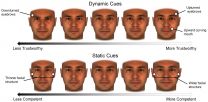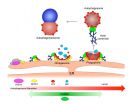New sleep genes found
Researchers discover that a protein called Taranis could hold the key to a good night's sleep
2015-06-18
(Press-News.org) PHILADELPHIA -- Most of us need seven to eight hours of sleep a night to function well, but some people seem to need a lot less sleep. The difference is largely due to genetic variability. In research published online June 18th in Current Biology, researchers report that two genes, originally known for their regulation of cell division, are required for normal slumber in fly models of sleep: taranis and Cyclin-dependent kinase 1 (Cdk1).
'There's a lot we don't understand about sleep, especially when it comes to the protein machinery that initiates the process on the cellular level,' says Kyunghee Koh, Ph.D., assistant professor of Neuroscience at the Farber Institute for Neurosciences at Thomas Jefferson University and senior author on the study. 'Our research elucidates a new molecular pathway and a novel brain area that play a role in controlling how long we sleep.'
The researchers examined thousands of mutant fly lines and found a mutant, called taranis, that slept a lot less than normal flies. Using a series of genetic and biochemical experiments, the researchers tracked how Taranis interacted with other proteins and saw that Taranis bound to a known sleep regulator protein called Cyclin A. Their data suggest that Taranis and Cyclin A create a molecular machine that inactivates Cdk1, whose normal function is to suppress sleep and promote wakefulness.
Previous research has shown that Cyclin A is expressed in a small number of neurons including a cluster of seven neurons on each side of the brain. Koh and colleagues showed that these neurons are located in an area of the fly brain that corresponds with the human hypothalamus -- one of the sleep centers of the human brain. They saw a reduction of overall sleep when Taranis was knocked down only in these 14 neurons and when these same neurons are activated. 'We think this may be an arousal center in the fly brain that Taranis helps inhibit during sleep,' says Koh.
Although the Taranis protein has a human cousin, called the Trip-Br family of transcriptional regulators, it is yet unclear whether a similar system is at play in humans. However, Dr. Koh and her team first plan to investigate the cues that turn Taranis on and which proteins the Cdk1 kinase acts on to prevent sleep.
INFORMATION:
This work was supported by NIH grant R01GM088221 and predoctoral fellowships from the Portuguese Foundation for Science and Technology.
For more information, contact Edyta Zielinska, 215-955-5291, edyta.zielinska@jefferson.edu.
Article reference: Afonso et al., 'TARANIS functions with cyclin a and cdk1 in a novel arousal center to control sleep in drosophila,' Curr Biol, DOI: 10.1016/j.cub.2015.05.037, 2015.
About Jefferson -- Health is all we do.
Our newly formed organization, Jefferson, encompasses Jefferson Health and Thomas Jefferson University, representing our clinical and academic entities. Together, the people of Jefferson, 19,000 strong, provide the highest-quality, compassionate clinical care for patients, educate the health professionals of tomorrow, and discover new treatments and therapies that will define the future of health care.
Jefferson Health comprises five hospitals, 13 outpatient and urgent care centers, as well as physician practices and everywhere we deliver care throughout the city and suburbs across Philadelphia, Montgomery and Bucks Counties in Pa., and Camden County in New Jersey. Together, these facilities serve more than 78,000 inpatients, 238,000 emergency patients and 1.7 million outpatient visits annually. Thomas Jefferson University Hospital is the largest freestanding academic medical center in Philadelphia. Abington Hospital is the largest community teaching hospital in Montgomery or Bucks counties. Other hospitals include Jefferson Hospital for Neuroscience in Center City Philadelphia; Methodist Hospital in South Philadelphia; and Abington-Lansdale Hospital in Hatfield Township.
Thomas Jefferson University enrolls more than 3,900 future physicians, scientists, nurses and healthcare professionals in the Sidney Kimmel Medical College (SKMC); Jefferson Schools of Health Professions, Nursing, Pharmacy, Population Health; and the Graduate School of Biomedical Sciences, and is home of the National Cancer Institute (NCI)-designated Sidney Kimmel Cancer Center
For more information and a complete listing of Jefferson services and locations, visit http://www.jefferson.edu.
ELSE PRESS RELEASES FROM THIS DATE:
2015-06-18
In 2012, researchers at the Stanford University School of Medicine showed that heart muscle cells made from the skin of people with a cardiac condition called dilated cardiomyopathy beat with less force than those made from the skin of healthy people. These cells also responded less readily to the waves of calcium that control the timing and strength of each contraction.
Now, the same research team has teased apart the molecular basis for these differences and identified a drug treatment that at least partially restores function to diseased cells grown in a laboratory ...
2015-06-18
Adult neural stem cells, which are commonly thought of as having the ability to develop into many type of brain cells, are in reality pre-programmed before birth to make very specific types of neurons, at least in mice, according to a study led by UC San Francisco researchers.
"This work fundamentally changes the way we think about stem cells," said principal investigator Arturo Alvarez-Buylla, UCSF professor of neurological surgery, Heather and Melanie Muss Endowed Chair and a principal investigator in the UCSF Brain Tumor Research Center and the Eli and Edythe Broad ...
2015-06-18
We can alter our facial features in ways that make us look more trustworthy, but don't have the same ability to appear more competent, a team of New York University psychology researchers has found.
The study, which appears in the Personality and Social Psychology Bulletin, a SAGE journal, points to both the limits and potential we have in visually representing ourselves--from dating and career-networking sites to social media posts.
"Our findings show that facial cues conveying trustworthiness are malleable while facial cues conveying competence and ability are significantly ...
2015-06-18
Want to lose abdominal fat, get smarter and live longer? New research led by USC's Valter Longo shows that periodically adopting a diet that mimics the effects of fasting may yield a wide range of health benefits.
In a new study, Longo and his colleagues show that cycles of a four-day low-calorie diet that mimics fasting (FMD) cut visceral belly fat and elevated the number of progenitor and stem cells in several organs of old mice -- including the brain, where it boosted neural regeneration and improved learning and memory.
The mouse tests were part of a three-tiered ...
2015-06-18
Last June, in the early days of the Ebola outbreak in Western Africa, a team of researchers sequenced the genome of the deadly virus at unprecedented scale and speed. Their findings revealed a number of critical facts as the outbreak was unfolding, including that the virus was being transmitted only by person-to-person contact and that it was picking up new mutations through its many transmissions.
While public health officials now believe the worst of the epidemic is behind us, it is not yet over, and questions raised by the previous work still await answers.
To ...
2015-06-18
PHILADELPHIA - Several well-known neurodegenerative diseases, such as Lou Gehrig's (ALS), Parkinson's, Alzheimer's, and Huntington's disease, all result in part from a defect in autophagy - one way a cell removes and recycles misfolded proteins and pathogens. In a paper published this week in Current Biology, postdoctoral fellow David Kast, PhD, and professor Roberto Dominguez, PhD, and three other colleagues from the Department of Physiology at the Perelman School of Medicine at the University of Pennsylvania, show for the first time that the formation of ephemeral compartments ...
2015-06-18
University of California San Francisco scientists have identified characteristics of a family of daughter cells, called MPPs, which are the first to arise from stem cells within bone marrow that generate the entire blood system. The researchers said the discovery raises the possibility that, by manipulating the fates of MPPs or parent stem cells, medical researchers could one day help overcome imbalances and deficiencies that can arise in the blood system due to aging or in patients with specific types of leukemia.
Similar imbalances can render patients vulnerable immediately ...
2015-06-18
PORTLAND, Ore. -- Advancing the field of structural biology that underpins how things work in a cell, researchers have identified how proteins change their shape when performing specific functions. The study's fresh insights, published online in the journal Structure, provide a more complete picture of how proteins move, laying a foundation of understanding that will help determine the molecular causes of human disease and the development of more potent drug treatments.
Though it has long been recognized that proteins are not static, for more than 30 years, scientists' ...
2015-06-18
The secret to preventing HIV infection lies within the human immune system, but the more-than-25-year search has so far failed to yield a vaccine capable of training the body to neutralize the ever-changing virus. New research from The Rockefeller University, and collaborating institutions, suggests no single shot will ever do the trick. Instead, the scientists find, a sequence of immunizations might be the most promising route to an HIV vaccine.
Scientists have thought for some time that multiple immunizations, each tailored to specific stages of the immune response, ...
2015-06-18
BOSTON, June 18 -- An analysis of five families has revealed a previously unknown genetic immunodeficiency, says an international team led by researchers from Boston Children's Hospital. The condition, linked to mutations in a gene called DOCK2, deactivates many features of the immune system and leaves affected children open to a unique pattern of aggressive, potentially fatal infections early in life.
As the researchers -- led by Kerry Dobbs and Luigi Notarangelo, M.D., of Boston Children's Division of Allergy and Immunology -- reported today in the New England Journal ...
LAST 30 PRESS RELEASES:
[Press-News.org] New sleep genes found
Researchers discover that a protein called Taranis could hold the key to a good night's sleep



